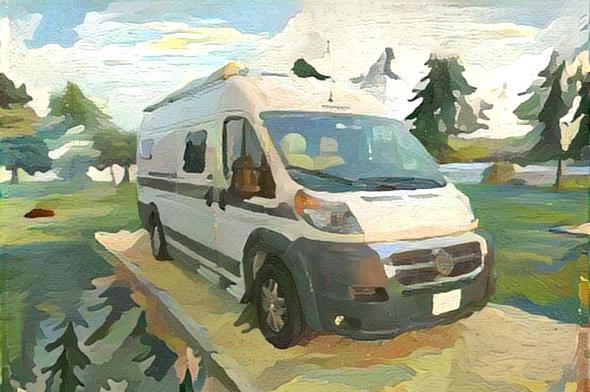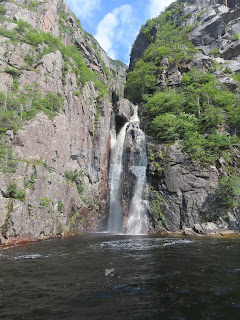Craggy: a steep or rugged coast
Craggy is the perfect word to describe the tall, sharp, jagged coastline of Newfoundland. It was artistically formed through the ages by the constant battering of ocean waves, and even today strong winds, rain, and fog on a daily basis add to the mystical appearance of this Atlantic wonder.
As our trip around this Canadian island continued into a second week, it became more apparent why this land is commonly referred to as ''The Rock''. Our journey to the eastern side of the island led us towards more craggy coastlines and scenic seashores. But, the question remained. Would we be able see one of the most iconic Newfoundland sights that line the coast during the summer months ... the puffin??
We sure hoped so as we left Gros Morne National Park and got back on the Trans-Canada Highway. We were more than happy to enjoy a few more hikes along the rocky cliffs and to savor a few more fresh cod dinners. But, to be able to sneak a peak of the bird whose silly appearance brings a smile to any face ... that could possibly be the perfect ending to our Newfoundland travels. Fingers crossed that there are possibly puffins still to be seen ''summering'' at one of their favorite rocky coastlines in the north Atlantic.
Craggy Coastline Hikes
Newfoundland is a hiker's paradise. Getting off the Trans-Canada Highway, we followed side roads which led us to coastline trails dotted with amazing ocean views. We also passed through another national park, Terra Nova, where the rugged coastline meets the boreal forests.
Some of the trails that we hiked included the Top of Twillingate Trail, the Coastal Trail in Terra Nova National Park, Gun Hill Trail, Skerwink Trail, Bonavista Shoreline Trail, and Spillar's Cove Trail.
Hiking in Newfoundland is always beautiful, but can be a bit challenging at times because of the constantly changing weather conditions.
But, whether we had clouds and drizzle accompanied by howling winds,
... or enjoyed bright sunshine reflecting off the deep blue water,
... Newfoundland's craggy coastlines provided artistic delights to anyone willing to seek them out.
Our favorite craggy coastline hike had to be Spillar's Cove Trail near the village of Bonavista. Even though it was one of those ''typical'' windy, cool, drizzly days, the crazy craggy rock formations made the effort of the hike well worth it.
There were warning signs along the trail advising us to not walk too close to the edge, and the reasons soon became quite apparent. When we were walking on the trail, apparently a section just ahead of us had fairly recently just fell into the ocean. Amazing to think that the wind and waves have enough power to continually increase the ''craggy-ness'' of this island's coast.
Scenic Sea Villages
Our travels through eastern Newfoundland led us through the scenic fishing villages of Twillingate, Trinity, and Bonavista.
The brightly colored docks,
... fishing boats,
... lighthouses,
... and waterfront views
made it easy to understand why tourists flock to these picturesque villages.
And where there are fishing boats, there has to be ...
seafood chowder,
and fish & chips
(and a moose burger ... just to say that we tried it)
One of my favorite scenic sea village was the tiny hamlet of Trinity.
This small fishing village contains many colorful saltbox houses that are being preserved as historical structures. Fun fact: these houses were painted bright colors in order to make it easier for the fishermen to find their way home in the foggy conditions that are so common here.
Trinity is also well-known for its artist studios and community theater that lures many tourists into town. Alas, attending the village theatrical production is one activity that seems to require a bit of pre-planning on our part as the tickets were all sold out the evening that we were there.
But walking around this cute village where the street signs are calligraphed and the lighthouse's foghorn lulls you to sleep still made great memories.
Other Newfoundland Highlights:
Amazing Boondocking Locations and New Traveling Buddies
Since we arrived in Canada, we came to the realization that ... Boondocking (ie camping for free outside of an established campground) is very abundant and beautiful in Canada. Using the application iOverlander, we spent many quiet nights in city parks and/or overlooking magnificent bodies of water.
During this second week in Newfoundland, we struck up a conversation with another van couple who were boondocking near us. Liz and Rémy, from western Canada, had recently started traveling in their converted van. They were following much the same route as us, so we enjoyed boondocking together a few more times as well as sharing travel stories at one of the local craft breweries.
Wild Blueberries!
Our new friends had also let us know that wild blueberries were out in abundance along many of the trails in Newfoundland. And as I quickly learned ... always bring a Zip-lock bag when hiking. The wild blueberries were practically begging to be picked, and they proved especially good over pancakes along with REAL Canadian maple syrup!
Pictures of Icebergs
(like on a wall ... not with my camera)
While it is sometimes possible to see icebergs off the coast of Newfoundland, we were here too late in the season, therefore we just enjoyed looking at the photos that were on display in a local museum.
Whales
(like just the skeleton, not the real deal)
We stopped at one of those ''side of the road'' museums and paid $5 each to walk through old fish shacks filled with sea-faring paraphernalia while hearing the ''fish tales'' that helped us understand life in these small fishing villages. At the waterfront was the skeleton of a Sei Whale that was found washed ashore and reconstructed in order to help visitors visualize the enormity of these magnificent sea creatures.
And ....
Possibly Puffins???
On our way for Trinity to Bonavista, we passed the small village of Elliston when the co-pilot noticed that there was a ''Puffin Viewing Site'' highlighted on Google Maps. Need to check this out! We arrived at the park and walked out with binoculars in hand in hopes that the thousands of puffins that migrate here every summer to have their young might still be hanging around.
The rocky cliffs and solitary rock islands that make up the summer nesting areas were very scenic,
but the only birds that seemed to be willing to be photographed from afar were of the quite ''common'' species.
A local photographer who was hanging out there with her long lens camera gave me hope when she said that she had spotted a few. But, being early September, most of the puffins had already flown off to their favorite winter hangouts.
But if we were patient enough, we could probably see a couple of them in flight. I got very excited when she pointed out one of them flying in the distance. Puffins have a very interesting flight pattern ... definitely not a ''soaring like an eagle'' type, but more like a ''flapping for dear life'' fellow. We were thoroughly entertained as we watched a few take off and land in the water in order to dive for some fish.
And then ...
... this cute one landed within our view on a huge cliff across the water from us.
A couple of them stayed long enough to allow me to snap a few pictures with my ''not quite so professional'' telephoto lens.
Cropping the photos highlights the colorful features of this unique bird.
One can't help but smile at these precious puffins!
Our ''see a puffin'' wish was fulfilled! We really enjoyed our time on Newfoundland despite the fact that it can be overcast, windy, and wet on a normal day-to-day basis ... that just added to the beauty that made Newfoundland one of our favorite RVenture destinations.
We were planning to spend a few more days on the island and hoped to check out the area around the provincial capital of St John's. But while listening to the local news, we started hearing a word that we thought only pertained to Florida during this time of the year ... hurricane. The heavy rain and strong winds of Hurricane Larry were predicted to arrive near St John's in a couple of days, and we were not sure that we wanted to experience the type of weather that a level 1 hurricane could bring.
So we got on the Trans-Canada Highway and drove eight hours back to Port aux Basques to catch the ferry back. While I was a little bummed to have to leave Newfoundland a few days early, it would also give us a few extra days to explore the provinces of Nova Scotia, New Brunswick and Prince Edward Island.
We loved our time exploring ''The Rock''
... a land of craggy coastlines,
... scenic sea villages,
and precious puffins ... a couple of whom may have possibly hitched a ride with us!
Someday, we hope to return and explore even more of this island. Until then, smiles are firmly planted on our faces as we fondly remember all the natural beauty and special friendships found in Newfoundland.
































































































